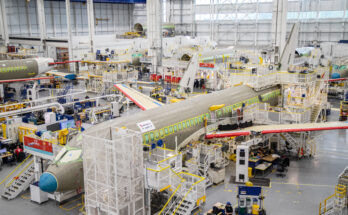By Ray Jaworowski, Senior Aerospace Analyst, Forecast International.

Data from Forecast International’s Platinum Forecast System 4.0 indicate that 29,407 large commercial jet transports will be produced in the 15-year period from 2018 through 2032. The value of this production is estimated at $4.73 trillion in constant 2018 U.S. dollars.
Yearly production of large commercial jetliners is projected to increase through most of the 15-year forecast period, rising from 1,607 aircraft in 2018 to 2,086 aircraft in 2029. However, this rise is not expected to be steady. Annual output is projected to be relatively flat from 2020 through 2022 before more substantial growth in yearly production resumes in 2023. Some minor retrenchment in annual build rates is predicted for the 2030-2032 timeframe.
Airbus and Boeing are projected to divide the market almost equally over the course of the 15-year forecast period. Boeing is forecast to produce 14,085 large commercial airliners during the 2018-2032 timeframe, representing a 47.9 percent share of the market. Airbus is projected to build 13,590 aircraft, for a market share of 46.2 percent. An additional 641 aircraft, all A220-300s, are expected to be built by a joint venture of majority partner Airbus and its A220/CSeries program teammate Bombardier. The remainder of the forecast production consists of a number of aircraft from other manufacturers, including the COMAC C919 from China and the Irkut MC-21 from Russia.
Both Airbus and Boeing are in the midst of navigating product line evolutions from certain legacy models to newer, upgraded variants. Airbus is transitioning to the A320neo and A330neo from earlier versions thereof, while Boeing is doing the same with the 737 MAX and the 777X. Boeing is also nearing a decision on whether to launch its New Midsize Aircraft (NMA), a clean-sheet design aimed at the middle of the airliner market.
The NMA would be positioned in the market space above current narrowbody airliners and below small widebodies such as the 787. The Boeing 757 once resided here, but the space is actually broader than what would be considered as strictly a 757 replacement market. How much broader, and thus how large the potential NMA market ultimately could be, is the key issue.
Accompanying the ongoing product line transformations is a trend among the giant OEMs toward insourcing. In their new aircraft programs, Airbus and Boeing are both taking on work responsibilities that had been outsourced on earlier projects. Potentially, this can result in greater profitability, more supply chain control, and increased aftermarket revenue for the OEMs. Maintenance, repair and overhaul work constitutes a very lucrative business, and Airbus and Boeing want to capture a bigger share of that business than they currently have.
Raymond Jaworowski currently co-authors three of Forecast International’s best-selling products: Civil Aircraft Forecast, Military Aircraft Forecast, and Rotorcraft Forecast. As a contributor to Aviation Week & Space Technology’s Aerospace Source Book, he has authored Aircraft Outlooks, and provided input for the publication’s Aircraft Specifications tables. Raymond has represented Forecast International at numerous conferences and trade shows, often as a featured speaker.
If you are attending the show, stop by our booth (Hall 1, Booth 1046) and meet Forecast International’s editorial vice president, Ray Peterson, to discuss how our products and services can serve your market research needs.
A military history enthusiast, Richard began at Forecast International as editor of the World Weapons Weekly newsletter. As the Internet grew in importance as a research tool, he helped design the company's Forecast Intelligence Center and currently coordinates the EMarket Alert newsletters for clients. Richard also manages social media efforts, including two new blogs: Defense & Security Monitor, covering defense systems and international issues, and Flight Plan, which focuses on commercial aviation and space systems. For over 30 years, Richard has authored the Defense & Aerospace Companies, Volume I (North America) and Volume II (International) services. The two books provide detailed data on major aerospace and defense contractors. He also edits the International Contractors service, a database that tracks all the contractors involved in the programs covered in the FI library. More recently he was appointed Manager, Information Services Group (ISG), a new unit that encompasses developing outbound content for both Forecast International and Military Periscope.



